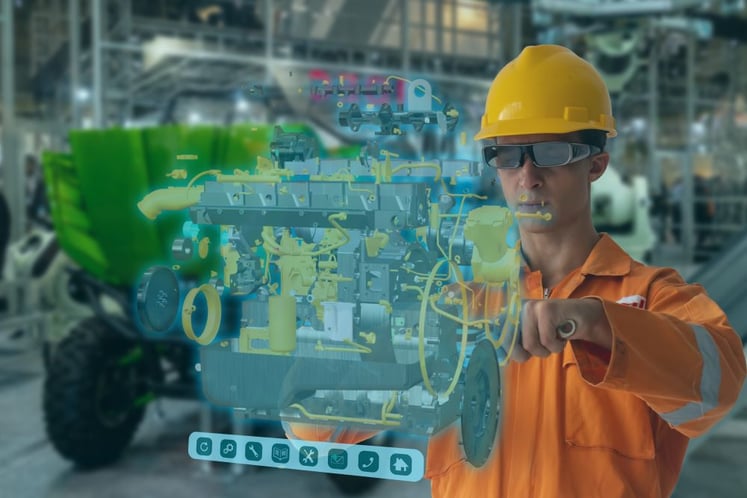
Are you dreaming about entering a virtual duplicate of your factory to monitor and correctly diagnose potential problems without visiting the physical facility? This idea is not new at all. It is quite last century, in fact. But we did not have the technology back then to implement digital twins as we know them today.
What is a digital twin?
A digital twin is a virtual environment of the part, machine, or facility. While a simulation focuses on a particular monitoring aspect or process, the digital twin can run any number of simulations and study several processes simultaneously in real time. Digital twins offer a two-way flow of information to gather operation data which then will be useful to act.
What applications can benefit from digital twins?
There are several applications in which digital twins provide a clear advantage. For example, you can use virtual twins for physically large projects like buildings, or bridges. This technology can be applied to mechanically complex projects; for example: jet or wind turbines, cars, trucks, trains, or aircraft. Finally, power equipment for generating or transmitting energy or manufacturing projects are also possible applications for virtual twins.
However, not all applications are good candidates for the technology. We must highlight that the more complex the project the more you can leverage a virtual twin. They offer an intense and regular flow of sensor data. As a result, you will face a high capital investment to implement a virtual twin, which cannot be justified from the financial standpoint unless you will achieve productivity and efficiency gains.
Benefits of digital twins
Having said that, digital twins can provide great advantages:
- Better Research and Development: The large amount of data provided by the digital twin sensors, if used appropriately, can shorten research and design phases of complex products, which in turn can improve ROI and time-to-market. In addition, the technology can help to gain useful insights into possible issues which can be corrected in the prototyping phase before production.
- Improved Efficiency: Digital Twins can be great to mirror and monitor from specific machines to complete production lines or manufacturing facilities. The technology can help you predict failures and issues that you can correct before they become problems. In turn, this will maintain peak efficiency throughout the entire manufacturing process.
- Lifecycle Management: Digital Twins help manufacturers plan the repair and replacement options for machines included in production lines. This avoids costly downtime and saves money in repairs. Digital Twins can also help to plan scheduled downtime to install new machinery which will be 100% compatible with current operations.
Hardware behind Digital Twins
In terms of hardware, this technology poses several challenges which we detail below:
Compatibility
Digital twins are interconnected devices through the Internet or Intranets. From the sensor level to the data center, your will need to connect hundreds of devices which must be able to transmit data in both ways. Some of the most modern manufacturing devices will include sensors and monitoring software. However, sometimes you will need to add sensors to machinery. Challenges start when choosing the appropriate sensor to gather the needed information and correct gateway to send and receive information to and from the computer or server. If you want to read more about sensors and gateways you can read this post and this post. As a result, the hundreds of devices can become an inventory problem which is common for distributed architectures. Make sure that you implement a structured maintenance plan for the digital twin to avoid losing track of the installed devices.
Large amount of data
The amount of data will increase exponentially the more complex the project or the larger the facility. Consequently, computers and servers will require powerful processing capabilities. This also means that you would probably need to have Cloud, Fog and Edge Computing capabilities already installed before attempting a full-blown digital twin of your factory. Therefore, you will depend on a reliable, fast and safe network (the Internet or Intranet) to efficiently transmit data both ways.
Rough environments
Industrial digital twins will depend on computers installed in the production floor to provide some data processing before sending it to the main servers. These computers need to offer special features like efficient cooling without a fan and protection against water or dust ingress. Industrial computers regularly require intensive 24/7 operation and withstand high temperatures. So, you may want to invest on specialized computers with appropriate certifications levels to work smoothly in tough industrial environments. You can read more about industrial computers in this post.
Security
When connecting devices to the Internet or Intranets, you always introduce security risks. With the increase rate of cyberattacks, both digital and physical, you should evaluate the need to add security features to your hardware. Some security features that you can ask the manufacturer to add to your hardware can be found in this post. These features will help you prevent physical access to your network, especially in machines or computers installed outside the secured Data Center environment. Remember that most attacks aim at obtaining sensitive information which can be used to extort money or damage a company’s reputation. If you want to learn more, visit our Cybersecurity Blog Series.
In conclusion, virtual twins already exist and can be a great tool to monitor, diagnose, and correct issues in factories. In the future, we could leverage virtual reality to “visit” the factory avoiding the actual physical visit which can be helpful for clean rooms or lights out facilities. Note that the investment on this type of technology is only worthwhile if the project is complex enough or large enough.
If you want to continue exploring the Metaverse or related technologies, you can visit the Metaverse Blog Series.